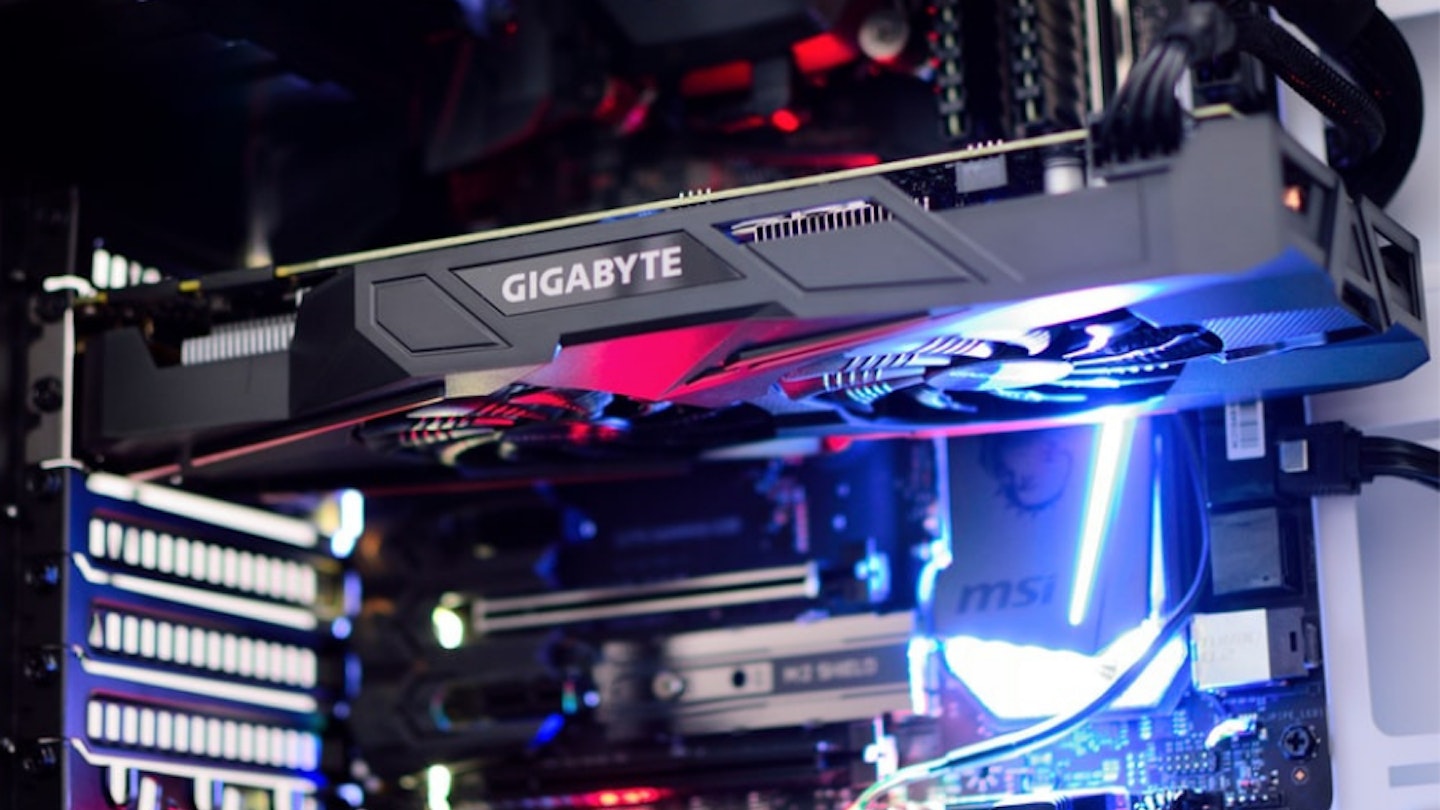Graphics cards have been in high demand and very low stock for a multitude of reasons; opportunistic scalpers, budding hobbyists amidst the COVID-19 pandemic, and of course, the worldwide silicon semiconductor chip shortage.
As a result, prices of graphics cards have inexorably sky-rocketed, leaving many gamers extremely frustrated and unable to upgrade and enjoy the latest games requiring some high-tier beefiness.
Fear not, however! We’ve assembled a comprehensive list of the best graphics cards for gaming that money can buy, all of which are available now.
If you're looking to grab yourself an entire rig that is ready to go, check out our choices for the absolute best gaming PCs for under £1000.
In compiling this list, we’ve considered the essential specifications of the graphics cards so as to not leave your head spinning with needless jargon, as well as the overall pro’s/cons of each card.
Note: All items were in stock and correctly priced at the time of writing. Due to issues with supply chains and high demand, some units may be temporarily unavailable.
The five best GPUs for gaming
1. Gigabyte GeForce RTX 3090
NVIDIA’s colossal RTX 3090 unsurprisingly tops the chart as one of the most powerful graphics cards on the market.
.png?auto=format&w=1440&q=80)
Fastest graphics card
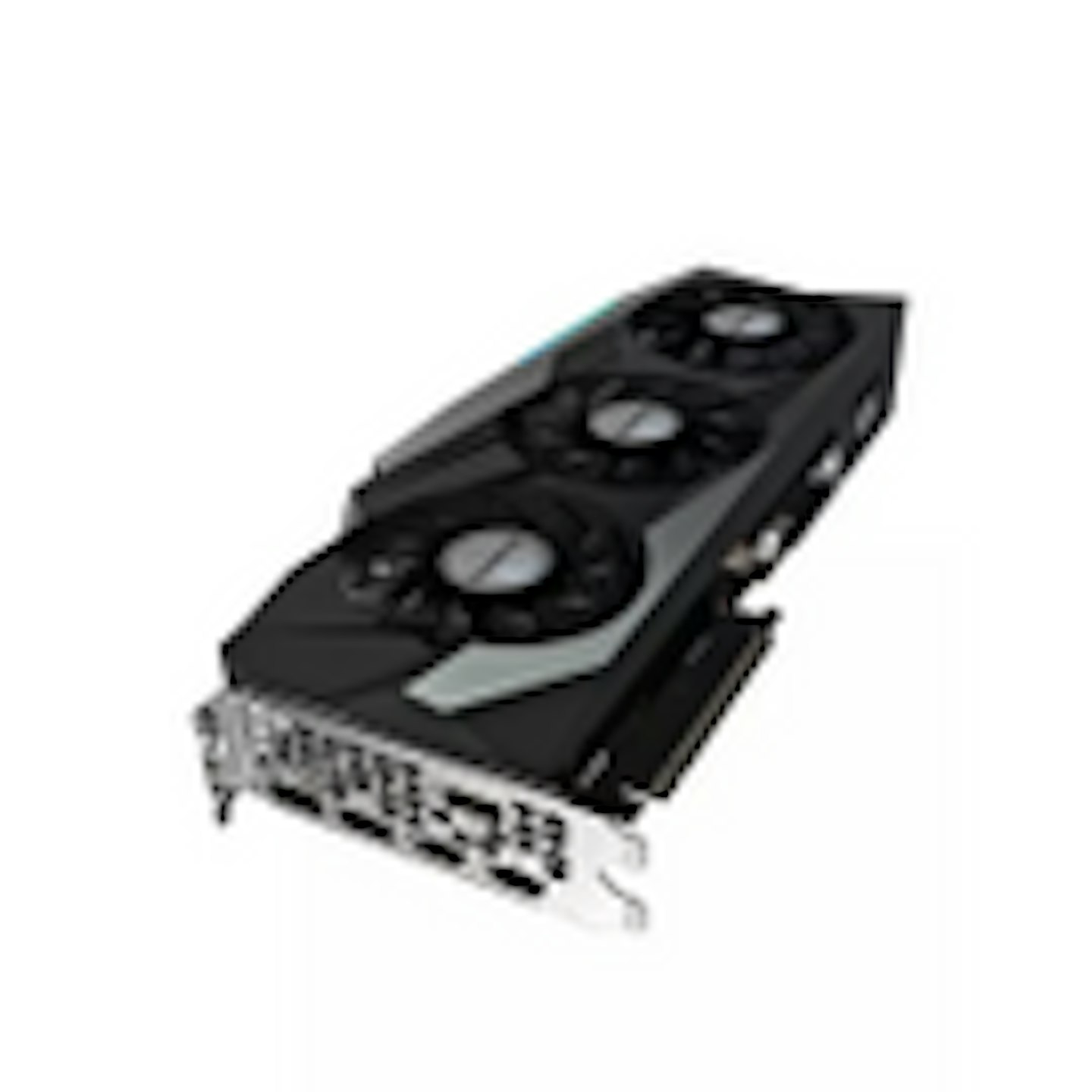 Very/ NVIDIA
Very/ NVIDIAwww.very.co.uk
| Pros | Cons |
|---|---|
| • Extremely powerful | • Very expensive due to price inflation |
| • Seamless 4K gameplay | • Bulky card may require new PC case |
| • Great build quality |
| Specifications | |
|---|---|
| Core Clock Speed: | 1.40GHz |
| Boost Clock Speed: | 1.70GHz |
| Memory: | 24GB GDDR6X |
| Memory Clock: | 1.2GHz |
| Architecture: | Ampere |
| TDP: | 350W |
| Suggested PSU: | 750W |
| CUDA Cores: | 10,496 |
| Outputs: | 1x HDMI 2.1, 3x DisplayPort 1.4a |
| Dimensions: | 336mm x 140mm x 61mm |
| Cooling: | Triple slot cooling |
Overview:
Launched in September 2020, NVIDIA’s flagship graphics card is, as of now, the premier graphics card for gaming. Boasting a whopping 24 GB of GDDR6X memory, the NVIDIA RTX 3090 is the epitome of true next-gen gaming.
Capable of supporting 8K resolutions - which are almost impossible to support on current hardware - the 3090 will effortlessly provide 4K gaming at 60-80 fps without breaking a sweat. The RTX 3090 also has essentially flawless ray-tracing capabilities, allowing for real-time generation of hyper-realistic light reflections that are stunning, they must be seen to be believed.
Watch: Cyberpunk 2077 RTX 3090 8K Resolution Ray Tracing on YouTube
NVIDIA’s exclusive DLSS technology, powered by its impeccable Ampere architecture, utilises AI and Deep Learning to model and simulate the behaviour of real light, as well as improve resolutions and graphical fidelity with little to no performance cost.
Watch: GeForce RTX 3090 + i9 12900K - Test in 10 Games on YouTube
However, all this top-tier tech comes at a price, and it is quite outrageous. Currently priced at £2,000 - a £500 increase from its launch - the NVIDIA RTX 3090 is truly the cutting-edge of graphics cards and is therefore priced as such. Another financial cost to consider is whether you’ll need a new PC case large enough to fit the card. Although the size varies depending on the manufacturer, it’s safe to say that any RTX 3090 variant will be very large.
If you’re looking to future-proof your PC for several years, and have the disposable income, then look no further, this is the graphics card for you. If, however, like many, this card is out of your price range, then it is as of now a needless expense and is largely unnecessary for a casual gaming experience.
You should also ensure that there's plenty of room in your budget for the rest of your PC components, as well your peripherals such as an excellent monitor, and a great keyboard.
2. AMD Radeon RX 6800 XT
AMD’S Radeon RX 6800 XT is truly a worthy competitor of the RTX 3080, and at a significantly cheaper price point, this high-end graphics card is a total steal.
.png?auto=format&w=1440&q=80)
Best value AMD graphics card
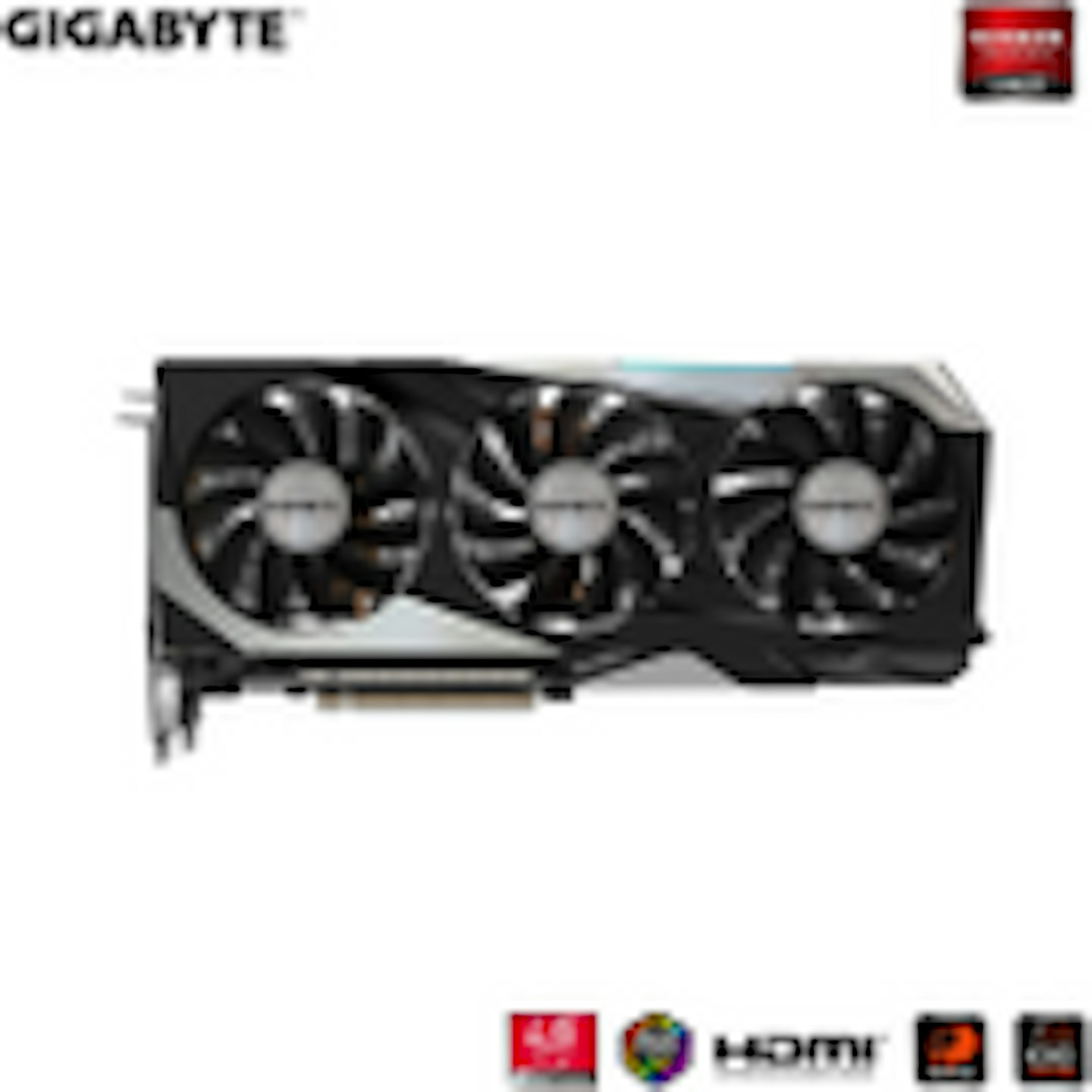 AMD/ Amazon
AMD/ Amazon| Pros | Cons |
|---|---|
| • Great 4K gaming | • Fidelity FX is weaker than NVIDIA's DLSS |
| • Solid build quality | • Slightly outdated GDDR6 memory |
| • Despite its cheaper price, the card is still very expensive |
| Specifications | |
|---|---|
| Core Clock Speed: | 1.80GHz |
| Boost Clock Speed: | 2.30GHz |
| Memory: | 16GB GDDR6 |
| Memory Clock: | 2.0GHz |
| Architecture: | RNDA |
| TDP: | 350W |
| Suggested PSU: | 700W |
| RDNA Cores: | 4,608 |
| Outputs: | 1x HDMI 2.1, 2x DisplayPort 1.4a |
| Dimensions: | 267mm x 120mm x 50mm |
| Cooling: | Dual slot cooling |
Overview
AMD’s Radeon RX 6800 XT was released in October 2020 and, unsurprisingly, has been in scarce supply since. AMD’s latest generation of graphics cards has decisively proven it’s a worthy competitor of NVIDIA and their 30-series.
The 6800 XT has an excellent 16GB of GDDR6 memory which, while comparatively lower than the RTX 3090, is more than ample to smoothly run most of the latest generation of games at a solid 60fps at 4K resolution.
However, AMD’s lower price point is made apparent by the much slower and largely outdated GDDR6 memory. Despite being only a half-generation behind, has 43% slower bandwidth, much slower than NVIDIA’s high-end graphics cards.
AMD’s graphics cards have made leaps and bounds in competing with NVIDIA over the past ten years, and their latest generation arrives ever closer to toppling NVIDIA’s market domination. Using the latest RDNA 2.0 architecture with a 65% performance increase over RDNA, released only two years prior, AMD’s 6000-series has some serious bandwidth.
Plus, AMD’s high-end 6000-series utilises Fidelity FX, a direct competitor to NVIDIA’s DLSS tech that serves to significantly increase performance at little-to-no cost to visuals and provide some ray tracing capabilities.
So, what’s the catch? Well, AMD Fidelity FX pales in comparison to NVIDIA DLSS, which is truly cutting-edge, offering far sharper visuals and ray tracing capabilities. While, yes, ray tracing is supported by the AMD 6800 XT, it leaves much to be desired in direct visual comparisons.
Despite being at a much lower price point than the NVIDIA 3090 and 3080, the AMD 6800 XT is still, due to high demand, very expensive. Retailing at £649 initially, the graphics card is currently sold for upwards of double this price currently. So, it’s perhaps recommended to wait a while for some cheaper offers (so you can afford an all-important gaming chair to accompany your shiny new rig). But, if you’re determined to get your build up and running as soon as possible, AMD’s 6800 XT is an excellent choice.
3. Gigabyte GeForce RTX 3080
Another fantastic yet scarce graphics card, the NVIDIA RTX 3080 is an impeccable card at a slightly cheaper cost than the 3090 and is all you need for even the most performance-intensive games this year.
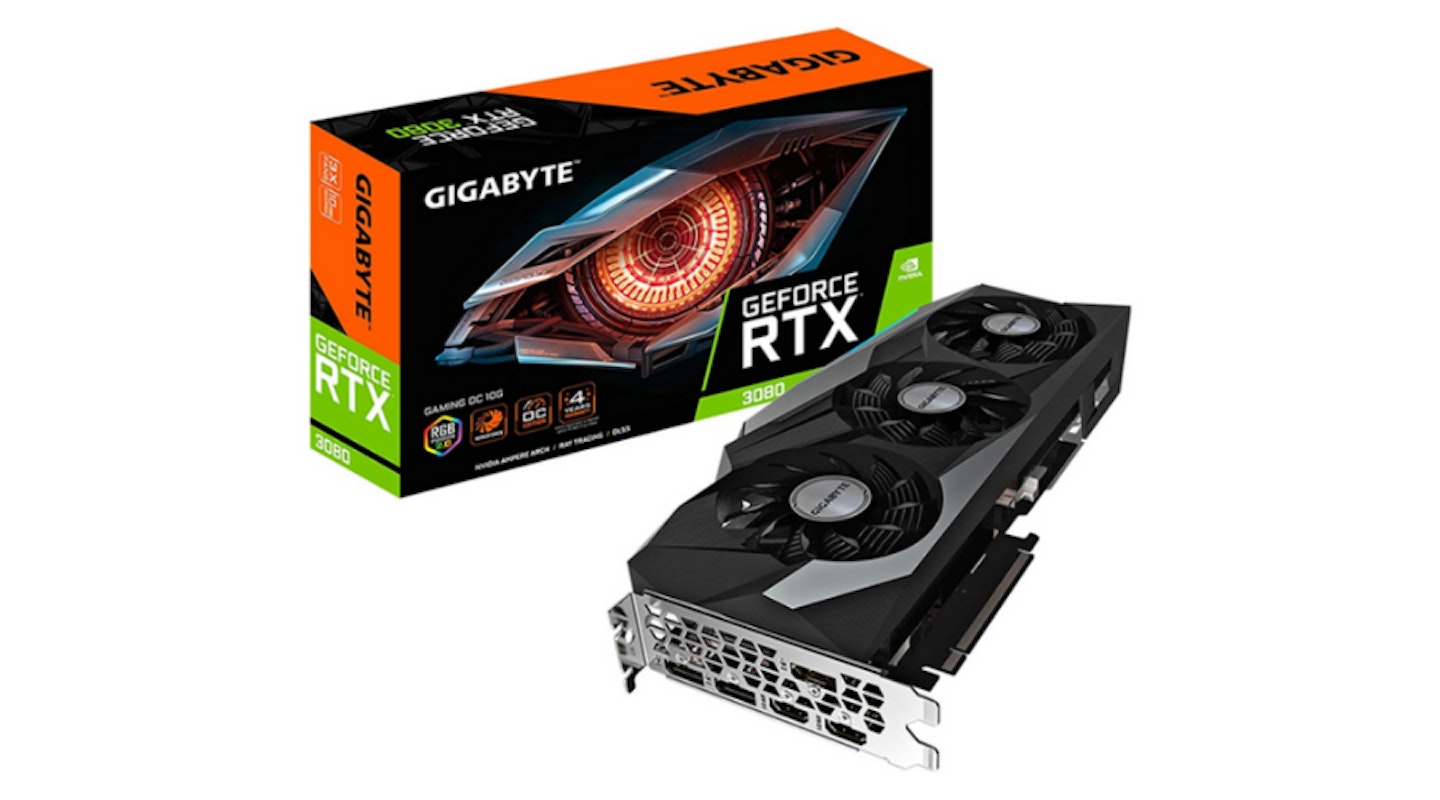
Best overall graphics card
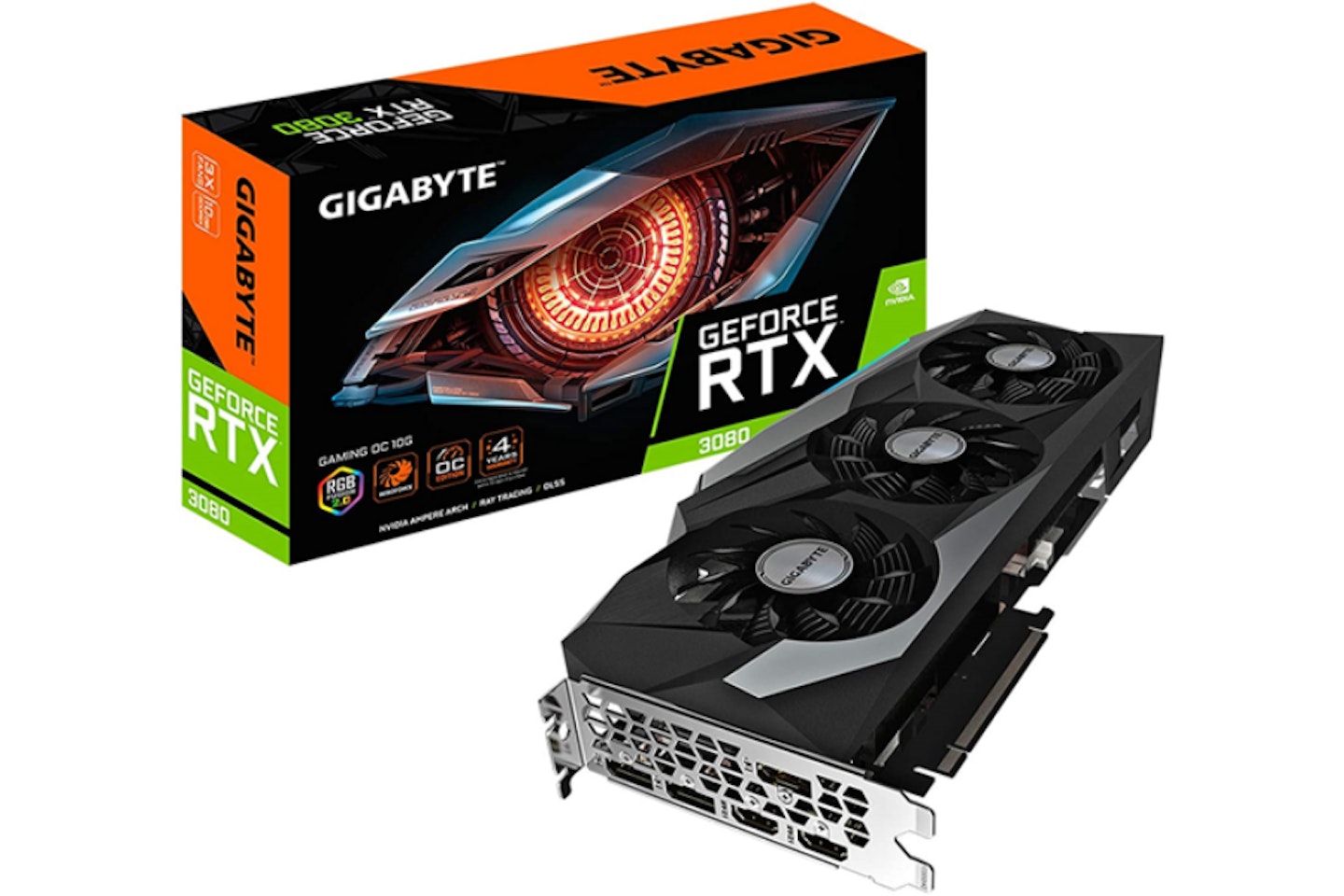 NVIDIA
NVIDIA| Pros | Cons |
|---|---|
| • Excellent 4K gaming | • Very expensive |
| • Ray tracing ready | • Very scarce supply making it a difficult card to find |
| • Latest DLSS technology | • Lower than expected VRAM for the price |
| Specifications | |
|---|---|
| Core Clock Speed: | 1.40GHz |
| Boost Clock Speed: | 1.70GHz |
| Memory: | 10GB GDDR6X |
| Memory Clock: | 1.20GHz |
| Architecture: | Ampere |
| TDP: | 320W |
| Suggested PSU: | 700W |
| CUDA Cores: | 8,704 |
| Outputs: | 1x HDMI 2.1, 3x DisplayPort 1.4a |
| Dimensions: | 285mm x 122mm x 40mm |
| Cooling: | Dual slot cooling |
Overview
NVIDIA’s GeForce 3080 graphics card is staggeringly powerful. Despite its slightly disappointing 10 GB GDDR6X memory, its impressive 8,704 CUDA cores ensure that your PC can handle whatever you can throw at it, including Crysis. Using the latest GDDR6X memory, all graphics cards in the 30-series have impeccable bandwidth. NVIDIA DLSS technology once again ensures that performance is not hindered by gaming at higher resolutions, hence 4K gameplay is largely flawless using this card.
So, why is it lower on the list? As of now, the RTX 3080 is more than double its retail price and is only narrowly more powerful than the AMD Radeon RX 6800 XT. For the absolute technophile who cannot live without the highest resolutions and some great ray tracing capabilities, then this is the card for you (at a more reasonable price than the RTX 3090), but as of now, this price is largely unjustified.
If you're feeling particularly adventurous and have the budget, you'll need to grab an excellent 4K monitor to complement your hefty machine, we have a great selection of4K curved monitors for your viewing pleasure.
4. Gigabyte GeForce RTX 3070 Ti
At a very reasonable price in the current graphics card market, NVIDIA’s RTX 3070 Ti deservedly ranks as one of the best graphics cards available today.
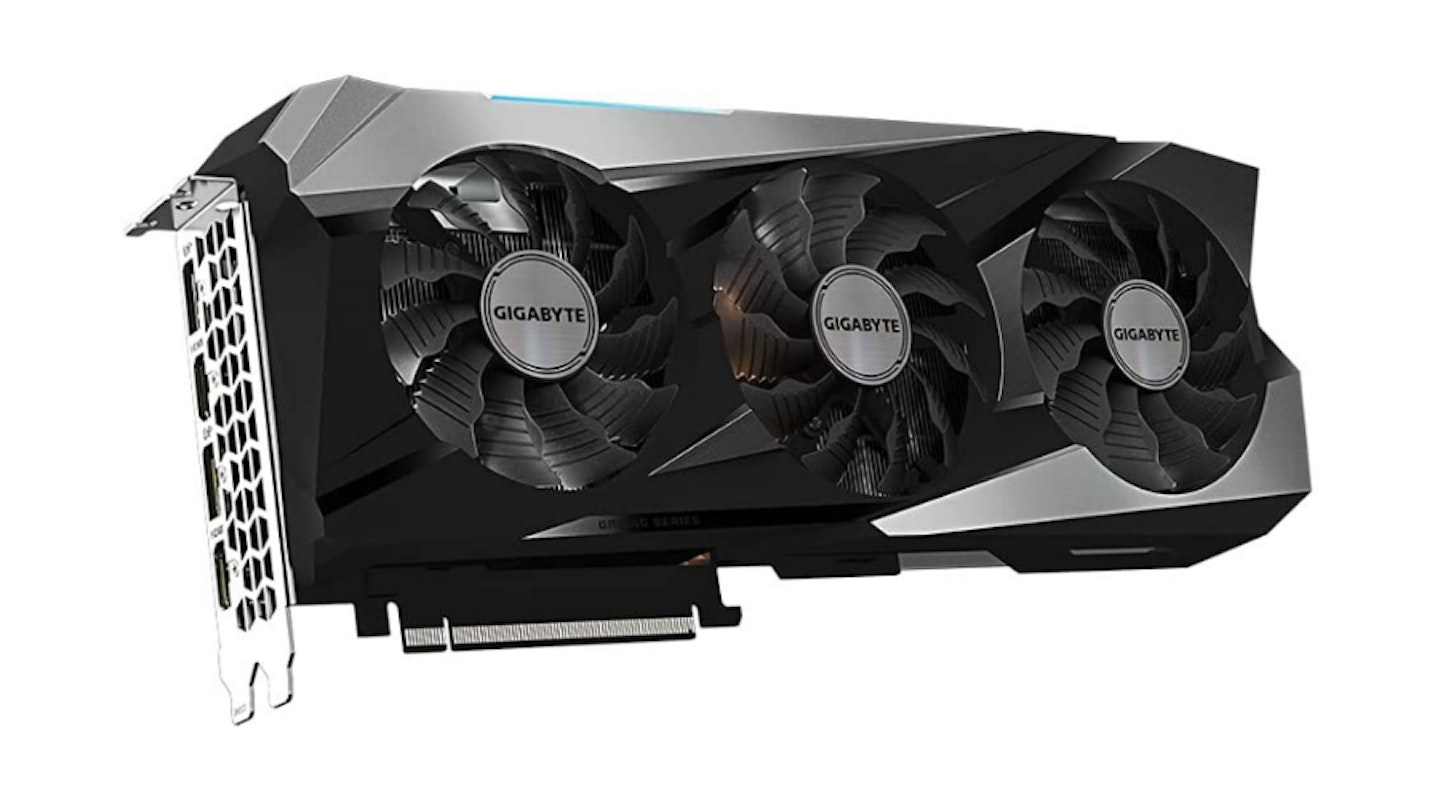
Best value graphics card
 NVIDIA/ Amazon
NVIDIA/ Amazon| Pros | Cons |
|---|---|
| • Excellent 1080p gaming | • Fairly low VRAM for 30-series graphics card |
| • Good 4K gaming | • Massively inflated price from initial release |
| • Great price for 30-series card | • Lower than expected VRAM for the price |
| Specifications | |
|---|---|
| Core Clock Speed: | 1.60GHz |
| Boost Clock Speed: | 1.80GHz |
| Memory: | 8GB GDDR6X |
| Memory Clock: | 1.20GHz |
| Architecture: | Ampere |
| TDP: | 290W |
| Suggested PSU: | 600W |
| CUDA Cores: | 6,144 |
| Outputs: | 1x HDMI 2.1, 3x DisplayPort 1.4a |
| Dimensions: | 267mm x 112mm x 40mm |
| Cooling: | WINDFORCE 3X cooling |
Overview
The RTX 3070 Ti still possesses the same excellent 30-series Ampere architecture and CUDA cores that guarantee ray tracing capabilities and widely good performance on most next-gen games. With a rather meagre 8GB GDDR6X memory and the same capacity as the 3070, the 3070 Ti was fraught with controversy at launch.
Many social media influencers denigrated the 3070 Ti’s £60 launch price difference from the 3070 for hardware that is only marginally more powerful. Yet surprisingly, the 3070 Ti is, as of now, at a significantly cheaper price point than the 3070 on Amazon and in most retail outlets.
Despite its more than reasonable price point, the 3070 is not higher up on the list purely due to its less-than-adequate 8 GB of memory. It’s certain to become obsolete in the coming years as games become ever-increasingly demanding. Yet, if you are looking for a reasonably priced and well-performing card that should effectively run a swathe of next-gen games, then look no further.
5. Gigabyte GeForce RTX 3060 Ti
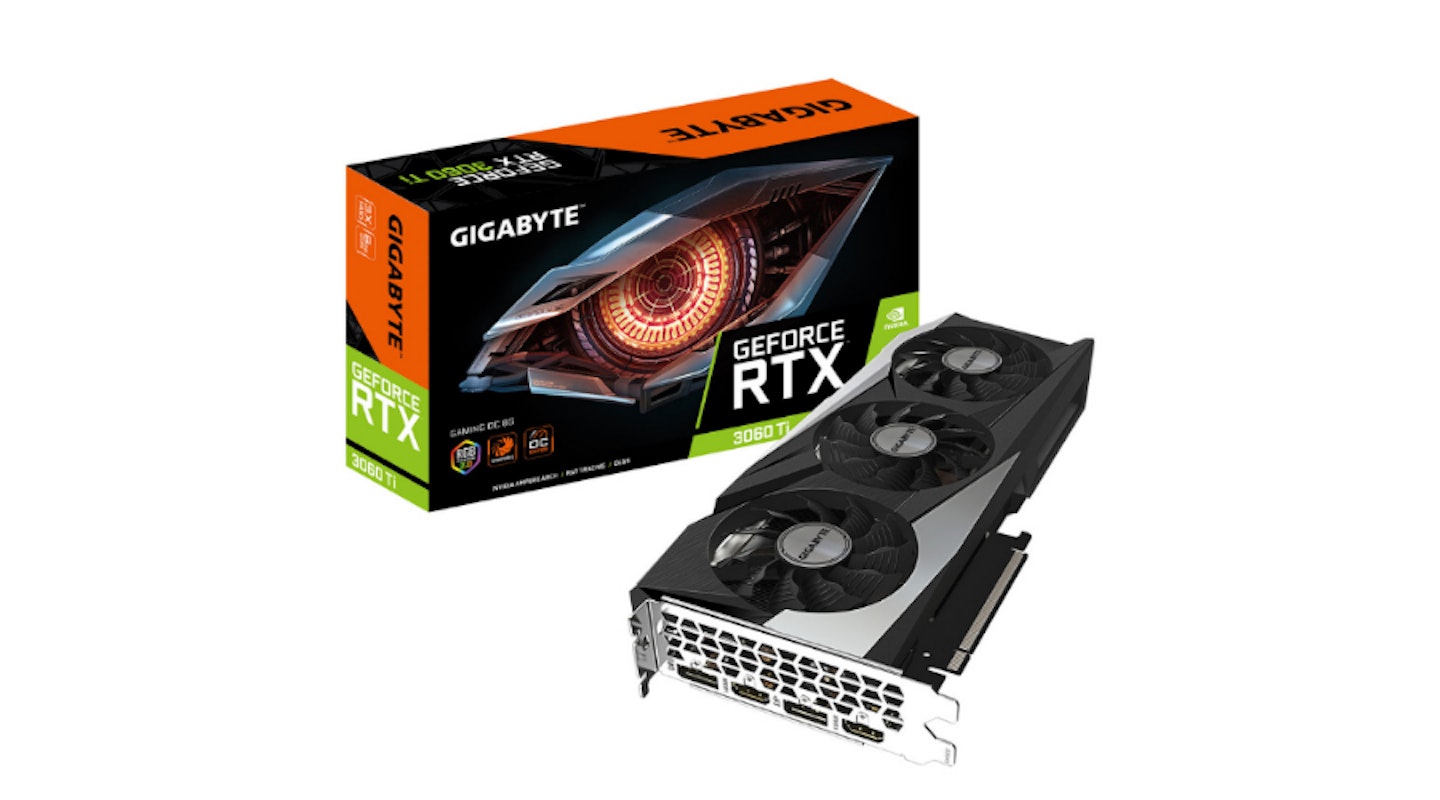
Despite being the most reasonably priced GPU on the list, the GeForce 3060 Ti remains a worthy contender as one of the best available graphics cards for gaming this year.
Best value NVIDIA graphics card
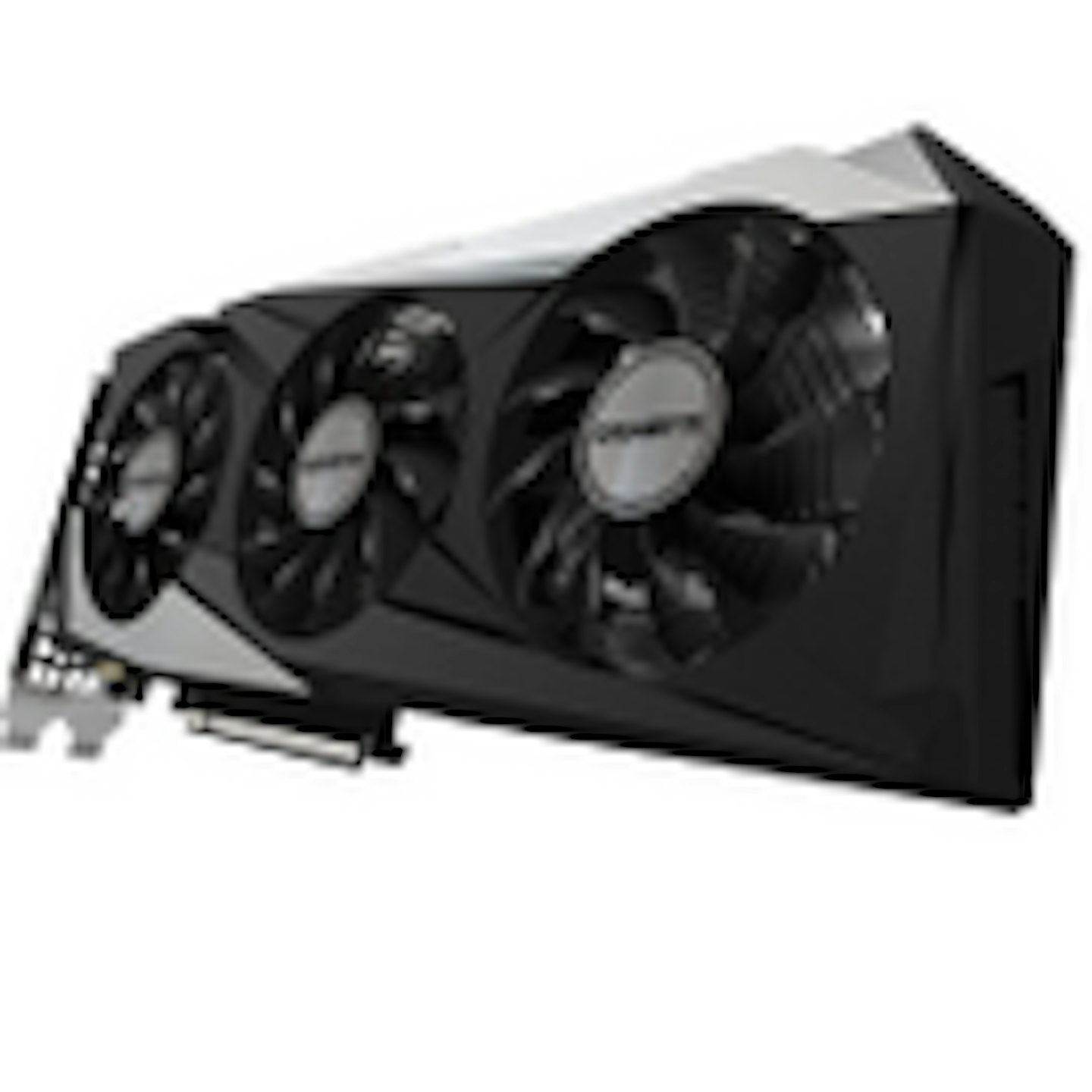 Amazon/ NVIDIA
Amazon/ NVIDIA| Pros | Cons |
|---|---|
| • One of the best budget cards | • Not entirely future-proofed |
| • Good 4K gaming with current releases | • Expensive despite being a cheaper option |
| • Great price for 30-series card | • Slower ray tracing in demanding games |
| Specifications | |
|---|---|
| Core Clock Speed: | 1.40GHz |
| Boost Clock Speed: | 1.70GHz |
| Memory: | 8GB GDDR6 |
| Memory Clock: | 1.80GHz |
| Architecture: | Ampere |
| TDP: | 200W |
| Suggested PSU: | 550W |
| CUDA Cores: | 4,864 |
| Outputs: | 1x HDMI 2.1, 3x DisplayPort 1.4a |
| Dimensions: | 242mm x 112mm x 40mm |
| Cooling: | Dual slot cooling |
Overview
A mid-range graphics card in NVIDIA’s 30-series, the 3060 Ti only has a meagre 8 GB of GDDR6 VRAM, a harsh distinction from cards such as the AMD Radeon 6800 XT and the GeForce 3080.
Yet, it grants you access to NVIDIA Ampere technology and an ample 4864 CUDA cores, meaning the card’s value for money cannot be beaten. Providing some excellent ray tracing capabilities at 1080p and 1440p, if you’re not looking for the sharpest image and, like many gamers are more than satisfied with 1080p gaming, then this GPU is almost certainly the upgrade you’ve been looking for. Plus, having a card with access to that all-new DLSS technology at such a low cost is worth the price of admission alone.
Of course, issues may arise as games are becoming far more demanding by the day, and despite being the cheapest option, graphics cards are for many people a major investment. If you’re looking to build an excellent budget PC with some fantastic 1080p gameplay and some decent 4K capabilities, then this graphics card is an excellent choice.
However, for a build that will remain future-proofed for years to come, it may be worth investing in some heftier hardware.
FAQ Section
What graphics card manufacturer should I use?
When looking for graphics cards, it can quickly become confusing as to which graphics card manufacturer to buy from, why are there ten variations of the same RTX 3080?
Usually, while general performance specifications will be almost the same, it’s important to look for a card that works well with your PC build. Different cards will have different cooling methods, different PSU requirement, and different external outputs, sizes and, of course, build qualities.
Our recommendation is that, if you can, you should get your hands on an NVIDIA or a Gigabyte graphics card. These cards are generally of the highest quality, yet this is often reflected in their daunting price tags.
Why is the GPU so important?
One of the most important components of your shiny new PC build, the GPU (or Graphics Processing Unit) does exactly what it says on the tin. The primary purpose of the GPU is to render graphics to your desktop display, therefore generating images onto your screen.
Prior to the 2000’s, early PCs used CPUs to process their graphics, but as gaming has evolved and higher resolutions have become widely available to consumers, high-power graphics cards have become a necessity. If you’re looking to build a truly powerful machine, then the graphics card should be the most expensive component you will need to buy.
What does VRAM do?
VRAM (or Video-RAM) stores image data for a computer’s display. The VRAM acts as a buffer between processes, once read by the GPU, it is stored temporarily in the VRAM and then sent via the HDMI cable (or other alternative multimedia output cables) to the display.
What's clock speed?
Also referred to as the “Engine Clock” or “Base Clock”, the clock speed is the measure of the operating frequency of the GPU, measured in processing cycles per second. The faster these cores' cycles are, the faster they can render graphics. Selecting a graphics card with a high clock speed is important if you’re looking to build a gaming PC, but a high clock speed is not always an indication of the best card.
What is overclocking?
Overclocking essentially uses a program, such as MSI Afterburner, to boost the clock speed of your PC, to increase the frequency of its processing cycles. Generally, the graphics card will specify the maximum safe overclock speed, as exceeding this limit can cause some major damage to your hardware.
What are CUDA Cores?
CUDA Cores are NVIDIA exclusive parallel processors, each core carries out individual graphics calculations, and therefore a greater core count equates to greater performance. When choosing your graphics card, it is important to note the architecture used, as with NVIDIA’s Ampere technology, their 30-series cards have seen a 40% boost in efficiency with their latest CUDA core processing, another reason why thorough benchmarking is so vital.
What are stream processors?
Stream Processors are the AMD equivalent of NVIDIA CUDA Core. They essentially perform the same parallel processing, yet many game developers work with CUDA cores in mind, and so there is less support in general for AMD Stream Processors. This may affect in-game stability - and performance in general - something to bear in mind if you’re looking to enjoy a specific game on your new setup.
Why is suggested PSU so important?
The PSU, or Power Supply Unit, is an internal component that supplies power to your desktop’s hardware. Ensuring your PSU can supply sufficient power to each component is essential for your PC to run, and with graphics cards and other components being generally more power-demanding, you should consider investing in a PSU with a high wattage.
Can a PSU be too powerful?
There’s a general misconception that a PSU with much higher wattage than your components require can cause some internal damage, yet this is entirely false. Components will generally draw their required wattage regardless of the PSU’s output. Often investing in a PSU that outputs a large wattage can boost PC longevity, also ensuring that you have room for some upgrades if needed.
What is memory bandwidth?
Bandwidth is a measure of data transfer between PC components, often measured in gigabytes per second (GB/sec).
What are tensor cores?
Tensor cores are processing units that carry out incredibly complex matrix multiplications in the form of tensors, large groups of data. Deep Learning algorithms and AI are extremely complex and convoluted processes to execute, so they require cores that can process these enormous calculations, as such the latest generation of Tensor cores allows for some amazing technological capabilities such as ray tracing and DLSS.
What is DLSS?
Deep Learning Super Sampling (or DLSS) is an AI rendering technology that is exclusive to NVIDIA. Using NVIDIA’s latest Ampere architecture and dedicated Tensor Core AI processors that are new with GeForce RTX GPUs, DLSS essentially uses AI to upscale image quality and detail while rendering only a fraction of the pixels, thus creating incredible visuals at little-to-no performance cost.
What is FidelityFX?
FidelityFX is the AMD answer to NVIDIA DLSS. Using similar upscaling technology, AMD can produce some high-quality resolutions at little-to-no performance cost.
What games are supported by NVIDIA and AMD?
NVIDIA has an absolute wealth of games supported and developed with NVIDIA GPUs in mind, some specific titles include Red Dead Redemption 2, Cyberpunk 2077, Control, Minecraft, and many more.
AMD also has developed a ton of mesmerizingly beautiful games that have astounded gamers over the past couple of years, including God of War, Far Cry 6, Deathloop, Resident Evil Village, and World War Z Aftermath.
